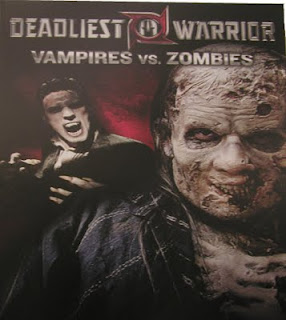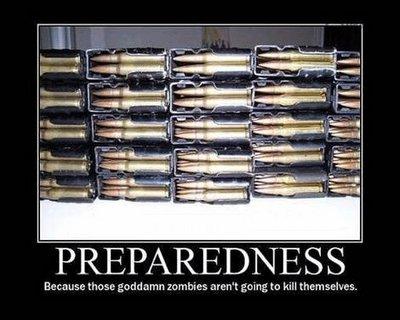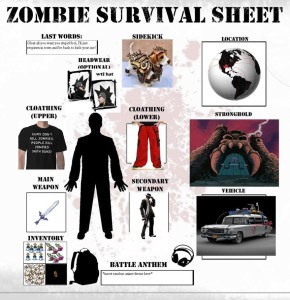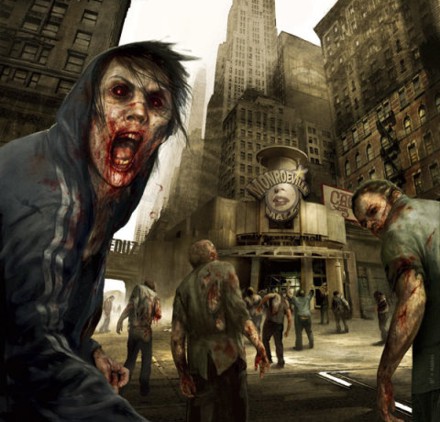Tag Archives: corpses
How a Zombie Outbreak Could Happen in Real Life
Could zombies actually exist? What would it take for human corpses to rise up and hunt the living? We often think zombies are scientifically impossible — but actually, they’re just very implausible. Here’s one wayThe Walking Dead could happen in real life.
To start our zombie thought experiment, we need to make some basic assumptions. First, we’re ignoring all supernatural zombie origins. We’re also going to set aside space radiation, mysterious comets, or Russian satellites. Our focus will be narrowed to biological origins –- a zombie contagion. Of course, there are many different zombie scenarios in books and film, and no one theory is going to cover all of them perfectly.
The first aspect of human zombification we need to tackle is basic zombie physiology. In virtually every zombie scenario, zombies are able to function despite increasing levels of physical deterioration due to injury or decomposition. There has to be some mechanism for transmitting neural impulses from the brain to various body parts, and for providing energy to muscles so they can keep operating.
The most common science fictional explanation for zombie outbreaks is a virus — but viruses and bacterial infections are not known for building large new physical structures within the body. So let’s count viruses out. Instead, the need for a mechanism to activate deteriorating body parts actually provides the cornerstone of what is, in my opinion, the strongest theory: fungal infection.

We know that fungi can infect humans. We also know that fungal networks exist in most of the world’s forests. These mycorrhizal networks have a symbiotic relationship with trees and other plants in the forest, exchanging nutrients for mutual benefit. These networks can be quite large, and there are studies that demonstrate the potential for chemical signals to be transmitted from one plant to another via the mycorrhizal network. That, in turn, means that fungal filaments could perform both vascular and neural functions within a corpse.
This leads us to the following scenario: microscopic spores are inhaled, ingested, or transmitted via zombie bite. The spores are eventually dispersed throughout the body via the bloodstream. Then they lie dormant. When the host dies, chemical signals (or, more accurately, the absence of chemical signals) within the body that occur upon death trigger the spores to activate, and begin growing. The ensuing fungal network carries nutrients to muscles in the absence of respiration or normal metabolism.
Part of the fungal network grows within the brain, where it interfaces with the medulla and cerebellum, as well as parts of the brain involving vision, hearing and possibly scent. Chemicals released by the fungi activate basic responses within these brain areas. The fungi/brain interface is able to convert the electrochemical signals of neurons into chemical signals that can be transmitted along the fungal network that extends through much of the body. This signal method is slow and imperfect, which results in the uncoordinated movements of zombies. And this reliance on the host’s brain accounts for the “headshot” phenomenon, in which grievous wounds to the brain or spine seem to render zombies fully inert.
This leaves the problem of zombie metabolism. Where do the zombies get the nutrients needed to perform physical activity, plus the necessary nutrients to fuel the life-cycle of the fungi? This is most easily explained by the zombies’ constant, endless drive to devour meat. The fungal network would still need some way to metabolize meat, and zombies seem to be able to function even in the absence of a human digestive system.
It is possible that this particular fungi has evolved a means to extract energy and nutrients from meat in a similar manner to carnivorous plants. The ingestion of meat may actually be vestigial, an unintended result of the drive to bite. In this case, the fungi may draw energy from the decomposition of the host’s own organic material, which effectively puts a shelf-life on zombies (in addition to the deterioration of body structures beyond the point where the fungal network can compensate).
Accounts of dismembered parts moving purposefully may be apocryphal.
Now we have established a working theory for fungal zombies. How could such a disease arise? The goal of any biological organism is to live long enough to reproduce, but many pathogens are self-limited by their own lethality. The host dies before it has a chance to spread the pathogen inadvertently. This gives us two pathways for development of the zombie fungus. First, a fungal species existed that used the digestive tracts of mammals to travel. In other words, animals ingested the fungus, including spores. The spores were later defecated out in a new location. Some mutations occurred that caused the spores to gestate while still within the host. However, in most cases, the host’s immune system would destroy the fungus. Further mutations could lead to spores that only trigger once the host has died, avoiding this problem.
Another possibility is a fungal infection that was highly aggressive and caused rapid death within the host. That strain was not able to successfully reproduce as often as a mutated strain that delayed activation until post-mortem.
Of course, it’s one thing for a fungus to activate after the host dies, and quite another for the dead host to stand up and start attacking things. There are many evolutionary steps in between, which is why a zoonotic origin seems likely.
The precursor fungus could have been ingested by pigs, which are omnivorous. Captive pig populations, subject to overcrowding, would have been perfect places for the fungus to spread and mutate. In some poorly managed pig farms, dead pigs may have gone unnoticed, allowing post-mortem development of the fungus. Dead pigs were likely partially eaten by their living counterparts, allowing the fungal strains with post-mortem mutations to spread back into the population. The method of transfer from the pig population to the human population seems fairly obvious.
The evolution of fully mobile dead pigs probably started with a simple bite reflex that could transmit spores to nearby pigs. A bite combined with a muscular spasm, a sort of lunge, would work even better. After many generations, this developed into full post-mortem mobility. Thus, a dead host went from a drawback to an advantage, becoming a mobile platform for spore distribution. In fact, the zombie hunger drive may have originated as a spore distribution method –- only later was the ability to metabolize meat acquired. We can extrapolate this development to assume the further refinement of the fungal neural system, allowing for zombies which are far more coordinated and can run at nearly full speed.
While this type of behavior modification may seem unlikely, there is precedent for it within the animal world. Several species of parasitic wasps are able to reprogram the behavioral patterns of their hosts (bees, ants and even caterpillars), creating complex new behaviors beneficial to the wasp and detrimental to the host. While the hosts in these cases aren’t dead, this does demonstrate that complex chemical overrides can evolve in nature.
Hopefully scientists can develop an effective zombie fungicide in time.
THE DEAD SHALL RISE – Vampire skeletons discovery comes after zombie apocalypse scare
 A discovery of vampire skeletons by scientists were found in Bulgaria. New of this comes on the heels of a bizarre zombie apocalypse scare from last week.
A discovery of vampire skeletons by scientists were found in Bulgaria. New of this comes on the heels of a bizarre zombie apocalypse scare from last week.
Archaeologists believe they’ve discovered centuries-old skeletons that were pinned down with iron rods going through their chests. It was a ritual done to the dead so they wouldn’t turn into vampires, FOX reports. The practice occurred in certain parts of Bulgaria and continued up until the turn of the last century.
Two skulls were found over the weekend near the Black Sea town of Sozopol in Bulgaria.
At the time time there was superstition that those who did evil when they were alive, would return from the dead and feast on the living’s blood. This prompted the hammering of iron rods through the dead’s chest bones and hearts.
Over 100 corpses around Bulgaria have been found stabbed as a way to prevent them from becoming vampires.
The latest news is a slight distraction from the horrific zombie apocalypse-like incidents that took place throughout the U.S. and Canada last week. At least this discovery is about skeletons, archaic beliefs, and traditional practices of the old ages. It’s seemingly less shocking compared to cannibalism!
The dangers of bragging about your zombie defense preparation
 You are prepared for the zombie apocalypse.
You are prepared for the zombie apocalypse.
You’ve stocked up on canned goods and ammunition. Your fortified treehouse is built high in the Rocky Mountains. You’re an expert marksman proficient in several different kinds of firearms. You’ve got your pilot license, your Wilderness EMT training, your black belt in Judo, and you’ve won the blue ribbon at the county fair three years running for your green thumb. You know how to make a weapon out of three paperclips and a crumpled Reese’s Peanut Butter Cup wrapper, and you can survive on nothing but tree bark and fingernail clippings for weeks.
You, sir or madam, are prepared for the day when the dead replace the living as the dominant species on Earth and theBRAAAAINS hit the fan. But that doesn’t mean you need to advertise the fact.
It might be tempting to brag to all your friends and neighbors (the ones you haven’t carefully selected as your zombie apocalypse companions for their special skills and ability to remain calm in the face of gruesome death) about how ready you are for the eventuality of zombies. But you must resist the temptation.
Those same people who consider you their “crazy zombie-obsessed friend” today will turn to you for help when the need arises. And when the need arises, corpses will be feasting on the living in the streets and society will face a swift and brutal collapse, so it’s fair to say that those less prepared than you will not be at their most rational or diplomatic.
Being burdened with several unprepared would-be survivors could spell doom for any meticulously planned survival strategy. These are the people who considered your little zombie fixation an “adorable quirk” and tolerated your defense preparations because you were their friend. They have done nothing on their own to make them a valuable asset in the post-zombiepocalyptic world. And they will drag you down.
At the first sign (Or maybe the second or third, since let’s face it: People tend to resist the most obvious explanation) of a zombie outbreak, these acquaintances will come running to you for help. They won’t know that they are merely zombie fodder waiting to happen, but you will. You cannot let them slow you down.
So keep your zombie defense preparations to yourself as much as possible. Don’t go bragging about how you’ll be living large on SPAM for years while they’re shambling about munching on carrion… and being carrion. It might feel good to boast now, but when that government experiment goes awry and corpses start clawing their way up from the grave, you don’t want to be saddled with a bunch of under-prepared dead weight.
Unless you like the idea of using bait, that is.
Stay informed, stay alive: What are some of your zombie defense preparations? Don’t worry, I won’t tell those pesky neighbors who laugh at you for your underground bunker now but will be moaning and shambling about your yard a minute after the first sign of a zombie outbreak.
How to Survive Miami’s Zombie Apocalypse, According to Zombie Expert Jonathan Maberry
 According to authorities, there’s a good chance that last week’s face-eating incident was the result of mind-altering drugs. (Just say no, kids.)
According to authorities, there’s a good chance that last week’s face-eating incident was the result of mind-altering drugs. (Just say no, kids.)
But according to the rest of us, it may signal the beginning of an inevitable threat Hollywood has warned us about for years: a zombie apocalypse. (Just ask The Miami zombie.)
Naturally, we’re all a little concerned that the undead may choose our sunny paradise as their next city of smorgasbord. After all, the heat is nice and lubricating for their stiff limbs.
So, in the interest of being prepared, we spoke to zombie expert Jonathan Maberry, author of Zombie CSU: The Forensics of the Living Dead on how best to survive a zombie apocalypse. Y’know, just in case.
Cultist: I’m sure you heard about the recent face-eating zombie attack in Miami. Any commentary?
Maberry: Within a few hours of the report hitting the news I was inundated by emails, IMs, Facebook and Twitter posts telling me, in essence, that the stuff I’ve been writing may not be fiction.
What would you say is the top rule of zombie survival?
Don’t be the dumb loudmouth in your group of survivors. These days, folks are likely to feed you to the zoms and make their escape during the chow-down.
What weapons or supplies should we procure to prepare ourselves?
In my series of teen post-apocalyptic zombie novels (Rot & Ruin, Dust & Decay, etc.) the smartest object of defense isn’t a gun or knife — it’s body armor made from carpet. You can’t really bite through it and there’s carpet everywhere. In the movies, the characters always run out into a crowd of zoms wearing ordinary clothes. I’d tear up the carpet, secure it with some duct tape (and we all have duct tape), and then stroll through the crowd of frustrated zombies.
Can we ply them with any other food besides human flesh?
If we accept the movies of George Romero as “zombie canon,” then the living dead eat everything — humans, animals, insects. We can always breed food for them. And it would provide jobs for farmers in a troubled economy.
How do zombies react to hot weather?
Zombies would thrive in hot weather. The heat keeps them limber. Cold would freeze them solid since body heat comes from blood flow. Of course, as the temperature rises, the zoms would spoil pretty quickly. Smelly … but eventually they’d fall apart.
Can zombies swim?
Zombies wouldn’t be a threat in the water. The freshly killed ones would sink like a stone without air in their lungs for buoyancy. The rotting ones might float because of gasses released by putrefaction, but they would lack the coordination for the mechanics of swimming and couldn’t strategize on how to overcome tides and currents. So, a great way to survive the zombie apocalypse is to strap on that Speedo and take a dip.
Are there different varieties of zombie?
There are several classifications of zombies. The old-school zombies are the raised dead used as slaves by priests of the Haitian religion of vodou. Since the 1960s we’ve come to hang the “zombie” nickname on flesh-eating ghouls of the Romero kind, and these are slow-moving, mindless corpses. Then there are the fast zombies, as introduced first in the film Return of the Living Dead (1985) and made famous in the 2004 Zack Snyder remake of Dawn of the Dead. Then you have the “rage virus-infected,” who are mindless humans infected by a disease that makes them kill everyone they meet. They were first introduced in George Romero’s 1973 flick The Crazies, then later became wildly popular in Danny Boyle’s 2002 classic, 28 Days Later and the 2010 remake of The Crazies. Oh, and Europe is famous for its demonically possessed zombies, and there have been a zillion of those films.
What’s the most common misconception about zombies?
The most common misconception about zombies is that the disease only spreads through bites. However Romero established that everyone who dies, no matter how or why, will rise as a zombies. Bites simply make it happen faster.
So there you have it. Get ready to tear up that carpet and make a swim for it, Miami.
‘Zombie apocalypse’ trending as bad news spreads quickly
 The term “zombie apocalypse” has been lighting up the internet all week and has been among the top Google trends Friday morning.
The term “zombie apocalypse” has been lighting up the internet all week and has been among the top Google trends Friday morning.
On the Web’s Urban Dictionary, here’s definition No. 4 of zombie apocalypse: “The End of the World, when people who have died rise again in rotten corpses searching for blood and brains to strengthen them.”
While we’re certain the dead are not rising, the past week has seen some of the most disturbing instances of human behavior imaginable.
A man in Miami happens upon a homeless man on the sidewalk and chews off 75% of his face in an 18-minute attack. The attacker’s mother later says her son is not a zombie as portrayed in the media.
Authorities in Canada have launched a massive manhunt for a suspect after a severed hand was sent to Canada’s Liberal Party, a foot to the Conservatives and a torso was stuffed in a suitcase and tossed in the trash of the Montreal apartment building where he lived.
A Maryland man admits to killing his housemate, cutting him up, then eating his heart and part of his brain.
A New Jersey man rips his torso open and throws bits of his intestines at police,according to the Bergen Record.
There have been other equally grisly crimes, but there’s no need to dwell on them.
Fact is, horrible crimes happen all the time.
“This is all nothing new,” said Scott Talan, professor of public communication at American University, with a long work history in public relations and the media.
Bad news attracts attention, he said, and when it happens in bunches, people like to attach a name to it, hence, “zombie apocalypse.”
People also like to see others in bigger trouble than they have themselves, Talan said.
“No matter how your life’s going, someone’s got it worse,” he said.
We like to think, “I’m better off than these people,” he said.
And that’s nothing new, Talan said, pointing out that ancient Roman philosophers used to lament that citizens felt little for the gladiators and what happened in their gruesome contests.
But he said while these stories catch fire quickly in our wired world, they flame out quickly, too.
Unless there’s another gruesome crime today, expect the zombie apocalypse to be done by next week, he said.
Even if that’s the case, there may be some good that can come of the attention zombie apocalypse has drawn on the Web.
A year ago, when zombie movies were the rage, the Centers for Disease Control and Prevention said if it could convince the public to prepare for the zombie apocalypse, maybe they’d be better prepared for disasters more likely to affect their lives, like earthquakes, hurricanes and tornadoes, or a major pandemic.
Or maybe the Mayan apocalypse. Talan points out that it isn’t real, it’s just a name like zombie apocalypse.
But then again, that isn’t supposed to happen until December. There’s still time for that go viral again.
